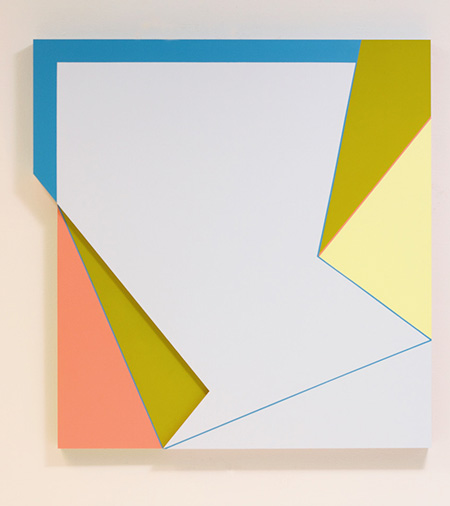
Continuing through November 26, 2017
The dual solo shows by Bay Area artists Connie Goldman and Mikey Kelly make a compelling argument for the best kind of formalist practice: work of museum quality (both artists have been collected at that level) that explores pure painting creatively. Notwithstanding the crisp, immaculate facture — no painterly blobs and drips here — this is art pursued with passion. The dogma of 1960s hard-edge formalism drew ridicule in Tom Wolfe's "The Painted Word," with critics supposedly squinting slantwise across a canvas' surface looking for suspicious painterly bumps. But the practice of geometric abstraction was always bigger than Clement Greenberg. The best reductivist or minimalist work — Mondrian, Reinhardt, Rothko, Newman, Stella, et al. — was always about more than paint on canvas stretched over wood.
Goldman’s show takes its title, “Genea," from the Greek word for becoming or emerging, as in ‘genealogy’ or ‘generate.’ The artist cites her interest in the “tenuous equilibrium” in which people and the world exist. Goldman: “Life is constant change. From one nanosecond to the next, from a minute to a decade, from a millimeter to a mile, there’s no chance of escaping the push and pull of time, nature, and volition.” Her eight painted relief sculptures, fashioned from MDF (a fine-grained pressed wood), with their irregular polygonal shapes, split-level planes and vibrant color palettes, are meticulously constructed puzzles, with double meanings and perceptual ambiguities.
Some planes seem folded over, like origami, or read as the shadows of other planes. Other planes in these reliefs are elevated or recessed, suggesting geological or architectural models. The multiple perspectives, overlapping forms, illusory folds, painted edges, and contradictory color and form make works like “Genea VI,” “Genea X” and “Genea XI,” my personal favorites here, vibrate with contradiction: distillations of imagination and experimentation that defy logic, but achieve a hard-won but seemingly effortless perfection.
Speaking of vibration and vibrancy, Kelly’s six overlapping-stripe acrylic paintings in “Vibrate” marry the Op Art of Bridget Riley and Jesus Rafael Soto to a compositional process involving algorithms. The goal is to arrive at what the artist calls "spirituality hacking." I am not clear on how the words that Kelly picks as titles are transformed or encoded by algorithms into these dazzling yet delicately woven arrays of stripes. They are made with an automobile paint striper and straightedge that seem to change from afar with the viewer’s movements. Close up they suggest complex crystalline or architectural structures.
"Be Love Now V1.0" and "Be Love Now V2.0,” both sixty-inch-diameter tondos, recall both the yarn-string projects that many of us made as children, and the scanned images of planets, simplified by pixelation. “Affirmations," a series of five twenty-four-inch square panels, carries a similarly hidden spiritual message in its title, with the colored lines changing hue according to the viewer’s angle of view and distance. The eye does the work, establishing an historical link with the Pointillist Divisionism of Seurat and Signac. "Seven Names of God Prayer V2.0," with its vertical adjoining panels, suggests (incorrectly) a prismatic version of the ROYGBIV rainbow color chart — red, orange, yellow, green, blue, indigo, violet — or an abstract, meditative, New Age version, perhaps, of Monet’s sun-kissed Rouen Cathedral. The sun is god, as Turner said.
